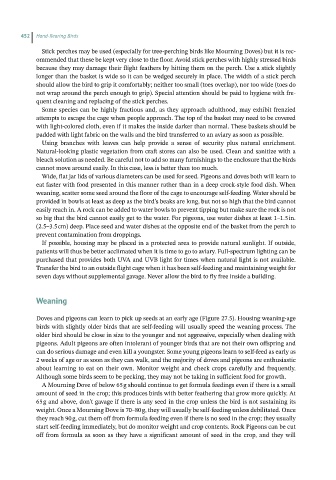Page 458 - Hand rearing birds second
P. 458
452 Hand-Rearing Birds
Stick perches may be used (especially for tree‐perching birds like Mourning Doves) but it is rec-
ommended that these be kept very close to the floor. Avoid stick perches with highly stressed birds
because they may damage their flight feathers by hitting them on the perch. Use a stick slightly
longer than the basket is wide so it can be wedged securely in place. The width of a stick perch
should allow the bird to grip it comfortably; neither too small (toes overlap), nor too wide (toes do
not wrap around the perch enough to grip). Special attention should be paid to hygiene with fre-
quent cleaning and replacing of the stick perches.
Some species can be highly fractious and, as they approach adulthood, may exhibit frenzied
attempts to escape the cage when people approach. The top of the basket may need to be covered
with light‐colored cloth, even if it makes the inside darker than normal. These baskets should be
padded with light fabric on the walls and the bird transferred to an aviary as soon as possible.
Using branches with leaves can help provide a sense of security plus natural enrichment.
Natural‐looking plastic vegetation from craft stores can also be used. Clean and sanitize with a
bleach solution as needed. Be careful not to add so many furnishings to the enclosure that the birds
cannot move around easily. In this case, less is better than too much.
Wide, flat jar lids of various diameters can be used for seed. Pigeons and doves both will learn to
eat faster with food presented in this manner rather than in a deep crock‐style food dish. When
weaning, scatter some seed around the floor of the cage to encourage self‐feeding. Water should be
provided in bowls at least as deep as the bird’s beaks are long, but not so high that the bird cannot
easily reach in. A rock can be added to water bowls to prevent tipping but make sure the rock is not
so big that the bird cannot easily get to the water. For pigeons, use water dishes at least 1–1.5 in.
(2.5–3.5 cm) deep. Place seed and water dishes at the opposite end of the basket from the perch to
prevent contamination from droppings.
If possible, housing may be placed in a protected area to provide natural sunlight. If outside,
patients will thus be better acclimated when it is time to go to aviary. Full‐spectrum lighting can be
purchased that provides both UVA and UVB light for times when natural light is not available.
Transfer the bird to an outside flight cage when it has been self‐feeding and maintaining weight for
seven days without supplemental gavage. Never allow the bird to fly free inside a building.
Weaning
Doves and pigeons can learn to pick up seeds at an early age (Figure 27.5). Housing weaning‐age
birds with slightly older birds that are self‐feeding will usually speed the weaning process. The
older bird should be close in size to the younger and not aggressive, especially when dealing with
pigeons. Adult pigeons are often intolerant of younger birds that are not their own offspring and
can do serious damage and even kill a youngster. Some young pigeons learn to self‐feed as early as
2 weeks of age or as soon as they can walk, and the majority of doves and pigeons are enthusiastic
about learning to eat on their own. Monitor weight and check crops carefully and frequently.
Although some birds seem to be pecking, they may not be taking in sufficient food for growth.
A Mourning Dove of below 65 g should continue to get formula feedings even if there is a small
amount of seed in the crop; this produces birds with better feathering that grow more quickly. At
65 g and above, don’t gavage if there is any seed in the crop unless the bird is not sustaining its
weight. Once a Mourning Dove is 70–80 g, they will usually be self‐feeding unless debilitated. Once
they reach 90 g, cut them off from formula feeding even if there is no seed in the crop; they usually
start self‐feeding immediately, but do monitor weight and crop contents. Rock Pigeons can be cut
off from formula as soon as they have a significant amount of seed in the crop, and they will

